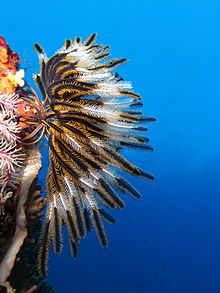
Back زنبق البحر Arabic زنابق البحر ARZ Dəniz lalələri Azerbaijani دنیز لالهلری AZB Марскія лілеі Byelorussian Морски лилии Bulgarian Morski krinovi BS Crinoïdeus Catalan Crinoidea CEB Lilijice Czech
| Crinoids Temporal range:
| |
|---|---|

| |
| Crinoid on the reef of Batu Moncho Island, Indonesia | |
| Scientific classification | |
| Domain: | Eukaryota |
| Kingdom: | Animalia |
| Phylum: | Echinodermata |
| Subphylum: | Crinozoa |
| Class: | Crinoidea Miller, 1821[2] |
| Major groups | |
| |
Crinoids are marine invertebrates that make up the class Crinoidea. Crinoids that are attached to the sea bottom by a stalk in their juvenile form are commonly called sea lilies, while the unstalked forms, called feather stars[3][4] or comatulids, are members of the largest crinoid order, Comatulida. Crinoids are echinoderms in the phylum Echinodermata, which also includes the starfish, brittle stars, sea urchins and sea cucumbers.[5] They live in both shallow water[6] and in depths as great as 9,000 meters (30,000 ft).[7]
Adult crinoids are characterised by having the mouth located on the upper surface. This is surrounded by feeding arms, and is linked to a U-shaped gut, with the anus being located on the oral disc near the mouth. Although the basic echinoderm pattern of fivefold symmetry can be recognised, in most crinoids the five arms are subdivided into ten or more. These have feathery pinnules and are spread wide to gather planktonic particles from the water. At some stage in their lives, most crinoids have a short stem used to attach themselves to the substrate, but many live attached only as juveniles and become free-swimming as adults.
There are only about 700 living species of crinoid,[8] but the class was much more abundant and diverse in the past. Some thick limestone beds dating to the mid-Paleozoic era to Jurassic period are almost entirely made up of disarticulated crinoid fragments.[9][10][11]
- ^ "Crinoidea - Digital atlas of Ancient life".
- ^ Hansson, Hans (2012). "Crinoidea". WoRMS. World Register of Marine Species. Retrieved 2013-01-30.
- ^ Gordon, D.P. (2009). New Zealand inventory of biodiversity: 1. Kingdom Animalia: Radiata, Lophotrochozoa, Deuterostomia. Christchurch: Canterbury University Press. p. 373. ISBN 978-1-877257-72-8.
- ^ McFall-Johnsen, Morgan; Lee, Lloyd (12 August 2023). "Scientists found a new sea creature with 20 'arms' and named it after a strawberry". Insider. Archived from the original on 12 August 2023. Retrieved 13 August 2023.
- ^ Cite error: The named reference
Ruppertwas invoked but never defined (see the help page). - ^ Zmarzly, D.L. (1985). "The Shallow-Water Crinoid Fauna of Kwajalein Atoll, Marshall Islands: Ecological Observations, Interatoll Comparisons, and Zoogeographic Affinities". Pacific Science. 39: 340–358. hdl:10125/941.
- ^ Oji, T.; Ogawa, Y.; Hunter, A. W. & Kitazawa, K. (2009). "Discovery of Dense Aggregations of Stalked Crinoids in Izu-Ogasawara Trench, Japan". Zoological Science. 26 (6): 406–408. doi:10.2108/zsj.26.406. PMID 19583499. S2CID 5991969.
- ^ Reproduction and Development in Echinodermata and Prochordata
- ^ Lucia, F. Jerry (1962). "Diagenesis of a Crinoidal Sediment". SEPM Journal of Sedimentary Research. 32: 848–865. doi:10.1306/74D70D8F-2B21-11D7-8648000102C1865D.
- ^ Blyth Cain, J. D. (September 1968). "Aspects of the depositional environment and palaeoecology of crinoidal limestones". Scottish Journal of Geology. 4 (3): 191–208. Bibcode:1968ScJG....4..191B. doi:10.1144/sjg04030191. S2CID 219538295.
- ^ Jach, Renata (April 2005). "Storm-dominated deposition of the Lower Jurassic crinoidal limestones in the Krížna unit, Western Tatra Mountains, Poland". Facies. 50 (3–4): 561–572. Bibcode:2005Faci...50..561J. doi:10.1007/s10347-004-0028-3. S2CID 128947091.
© MMXXIII Rich X Search. We shall prevail. All rights reserved. Rich X Search